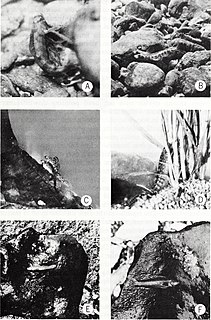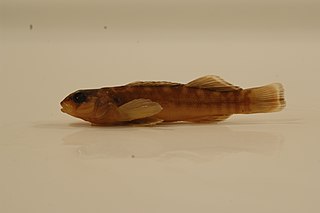
The Rio Grande darter is a small species of ray-finned fish, a darter from the subfamily Etheostomatinae, part of the family Percidae which includes the perches, ruffs and pike-perches. It is endemic to the lower Rio Grande drainage of the United States and Mexico. It inhabits riffles over substrates of gravel or rubble. This species can reach a length of 6 cm (2.4 in), though most only reach about 3 cm (1.2 in). The Rio Grande darter was first formally described as Oligocephalus grahami in 1859 by the French zoologist Charles Frédéric Girard (1822-1895) with the type locality given as the Devils River in Texas. The specific name honors the American soldier and topographer James Duncan Graham (1795-1865), who led the expedition on which the type was collected by John H. Clark.

The Niangua Darter is a species of freshwater ray-finned fish, a darter from the subfamily Etheostomatinae, part of the family Percidae, which also contains the perches, ruffes and pikeperches. It is endemic to Missouri, United States. It is found only in the Osage River Basin of central Missouri where its range historically included the Sac River, Pomme de Terre River, Niangua River, Big Tavern Creek, and Maries River. It is a federally listed threatened species of the United States.

Etheostoma osburni, the candy darter or finescale saddled darter, is a species of fish in the family Percidae, a member of the group known as darters. This species is endemic to the eastern United States where it is known only from the Kanawha River system in the states of Virginia and West Virginia.

The boulder darter species of freshwater ray-finned fish, a darter from the subfamily Etheostomatinae, part of the family Percidae, which also contains the perches, ruffes and pikeperches. It is endemic to Alabama and Tennessee in the United States, where it occurs in the Elk River system and Shoal Creek. It is found in small rivers and fast-flowing streams, at least 2 ft (0.6 m) deep, with boulders or a rocky base. It feeds on aquatic insect larvae but little is known of its natural history. The population trend of this fish is unknown but it is affected by a rise in siltation and the impoundment of water within its range by the building of dams. The International Union for Conservation of Nature has assessed its conservation status as being "vulnerable".

The mud darter is a species of freshwater ray-finned fish, a darter from the subfamily Etheostomatinae, part of the family Percidae, which also contains the perches, ruffes and pikeperches. It is endemic to the lowlands of the Mississippi River basin from Wisconsin and Minnesota south to Louisiana and East Texas. It is also found in the drainages of the Sabine and Neches Rivers of Texas and Louisiana. It can be found in slow-moving waters on riffles in rivers, as well as in creeks, swamps, lakes, and reservoirs. It mostly consumes the larvae of midges and blackflies. This species can reach a length of 7.1 cm (2.8 in), though most only reach a length of 5 cm (2.0 in).

The teardrop darter is a species of freshwater ray-finned fish, a darter from the subfamily Etheostomatinae, part of the family Percidae, which also contains the perches, ruffes and pikeperches. It is endemic to the eastern United States. It is only found in Kentucky and Tennessee, where it occurs in the middle to upper reaches of the Green River drainage. It inhabits small rivers and creeks and rocky pools where it feeds on the larvae of blackflies and midges, immature stages of caddisflies and mayflies, and cladocerans and copepods. This species can reach a length of 6 cm (2.4 in), though most only reach about 4.2 cm (1.7 in). This species creates nests in which the females depsit their eggs and these are guarded by the male and have been found to contain between 40 and 80 eggs. The teardrop darter was first formally described by Robert A. Kuehne and James W. Small Jr. in 1971 with the type locality given as Brush Creek, a tributary of the Green River, 2.7 miles north of Liberty, Casey County, Kentucky. The specific name honours Professor Roger W. Barbour (1919-1993) in recognition of his contribution to the knowledge of Kentucky's vertebrate fauna.
The egg-mimic darter is a species of freshwater ray-finned fish, a darter from the subfamily Etheostomatinae, part of the family Percidae, which also contains the perches, ruffes and pikeperches. It is endemic to the eastern United States, where it is only known from the Duck River drainage of Tennessee. It inhabits creeks and headwaters, living in pools with very slow current. This species can reach a length of 6.1 cm (2.4 in). The fish's common name refers to round, fish egg-like yellow knobs projecting from the rays of the male’s second dorsal fin, these “false eggs” attract females to spawn with the male.
The stippled darter is a species of freshwater ray-finned fish, a darter from the subfamily Etheostomatinae, part of the family Percidae, which also contains the perches, ruffes and pikeperches. It is found in Missouri and White River drainages in Ozark Uplands of Missouri and Arkansas. Isolated population occurs in upper Castor River of southeastern Missouri. It inhabits rocky pools of headwaters and creeks. This species can reach a length of 10.0 cm (3.9 in).
The striped darter is a species of freshwater ray-finned fish, a darter from the subfamily Etheostomatinae, part of the family Percidae, which also contains the perches, ruffes and pikeperches. It is found in the lower Cumberland River drainage in Kentucky and Tennessee, in the upper Caney Fork system in central Tennessee; and in Rockcastle River and nearby streams in eastern Kentucky. It inhabits rocky pools of headwaters, creeks and small to medium river. This species can reach a length of 7.8 cm (3.1 in), though most only reach about 4.8 cm (1.9 in).
The turquoise darter is a species of ray-finned fish, a darter from the subfamily Etheostomatinae, part of the family Percidae which includes the perches, ruffes and pike-perches. It is found in the Edisto, Savannah and Altamaha River drainages of North Carolina, South Carolina and Georgia. It inhabits rocky riffles of creeks and small to medium rivers. This species can reach a length of 8.0 cm (3.1 in), though most only reach about 6.0 cm (2.4 in).
The riverweed darter is a species of freshwater ray-finned fish, a darter from the subfamily Etheostomatinae, part of the family Percidae, which also contains the perches, ruffes and pikeperches. It is endemic to the eastern United States, where it occurs in the upper Roanoke River drainage in Virginia and North Carolina. It inhabits rocky riffles of creeks and small rivers. This species can reach a length of 7.6 cm (3.0 in).

The Carolina darter is a species of freshwater ray-finned fish, a darter from the subfamily Etheostomatinae, part of the family Percidae, which also contains the perches, ruffes and pikeperches. It is endemic to the eastern United States, where it occurs in the Atlantic Piedmont from Roanoke River drainage of Virginia to Santee River drainage of South Carolina. It inhabits muddy and rocky pools and backwaters of sluggish headwaters and creeks. This species can reach a length of 6 cm (2.4 in). The Carolina darter was first formally described in 1935 as Hololepis collis by the American ichthyologists Carl Leavitt Hubbs (1894-1979) and Mott Dwight Cannon with the type locality given as a creek near York, South Carolina.
The Kentucky darter is a species of freshwater ray-finned fish, a darter from the subfamily Etheostomatinae, part of the family Percidae, which also contains the perches, ruffes and pikeperches. It is endemic to the eastern United States, where it occurs in the upper Green and Gasper River systems in Kentucky. It inhabits rocky pools and adjacent riffles of creeks and small rivers. It has a diet that mainly consists of mayflies, larval blackflies, midges and occasionally various insect larvae. This species can reach a length of 6.5 cm (2.6 in).
The backwater darter is a species of freshwater ray-finned fish, a darter from the subfamily Etheostomatinae, part of the family Percidae, which also contains the perches, ruffes and pikeperches. It is endemic to the eastern United States, where it occurs in coastal plain streams in the Mobile Bay drainage in Alabama and Mississippi. It occurs mud-bottomed, often vegetated, pools of sluggish creeks and small rivers. This species can reach a length of 4.4 cm (1.7 in).
The Missouri saddled darter is a species of freshwater ray-finned fish, a darter from the subfamily Etheostomatinae, part of the family Percidae, which also contains the perches, ruffes and pikeperches. It is endemic to Missouri, where it occurs in the Ozarks from the Gasconade River to the Osage and Moreau rivers. It occurs in fast gravel and rubble riffles of small to medium rivers. This species can reach a length of 9.0 cm (3.5 in).

The orangebelly darter is a species of freshwater ray-finned fish, a darter from the subfamily Etheostomatinae, part of the family Percidae, which also contains the perches, ruffes and pikeperches. It is endemic to the eastern United States, where it occurs in the Ouachita and Red River drainages in southwestern Arkansas and southeastern Oklahoma. It occurs in gravel and rubble riffles and runs of creeks and small to medium rivers. This species can reach a length of 8.5 cm (3.3 in).
The Arkansas saddled darter is a species of freshwater ray-finned fish, a darter from the subfamily Etheostomatinae, part of the family Percidae, which also contains the perches, ruffes and pikeperches. It is endemic to the eastern United States, where it occurs in the White River drainage in Arkansas and Missouri. It occurs in deep, fast gravel and rubble riffles of small to medium rivers. This species can reach a length of 12.0 cm (4.7 in).

The Creole darter is a species of freshwater ray-finned fish, a darter from the subfamily Etheostomatinae, part of the family Percidae, which also contains the perches, ruffes and pikeperches. It is endemic to the eastern United States, where it occurs in the Ouachita, Red, Calcasieu and Sabine River drainages in Arkansas and Louisiana. It inhabits gravel riffles, current-swept vegetation and debris in creeks and small to medium rivers. This species can reach a length of 7.4 cm (2.9 in). The creole darter was first formally described in 1969 by Ray S. Bridsong and Leslie William Knapp with the type locality given as the Dugdemona River, Jackson Parish, Louisiana. The specific name honours of the American ichthyologist Bruce Baden Collette, then of the Bureau of Commercial Fisheries Systematics Labroratory, to recognise his contribution to the study of the fishes of the perch family.
The Shawnee darter is a species of freshwater ray-finned fish, a darter from the subfamily Etheostomatinae, part of the family Percidae, which also contains the perches, ruffes and pikeperches. It is endemic to the eastern United States, where it occurs in the upper Pond River in Kentucky. It inhabits shallow gravel riffles and rocky runs and pools of headwaters, creeks, and small rivers. This species can reach a length of 5.4 cm (2.1 in).
The Tennessee darter is a species of freshwater ray-finned fish, a darter from the subfamily Etheostomatinae, part of the family Percidae, which also contains the perches, ruffes and pikeperches. It is endemic to the eastern United States, where it occurs in the Tennessee River drainage from western Virginia to western Tennessee. It also occurs in the upper Bluestone River drainage in western Virginia. It inhabits current-swept rocky pools and adjacent riffles of creeks and small to medium rivers. This species can reach a length of 6 cm (2.4 in).










